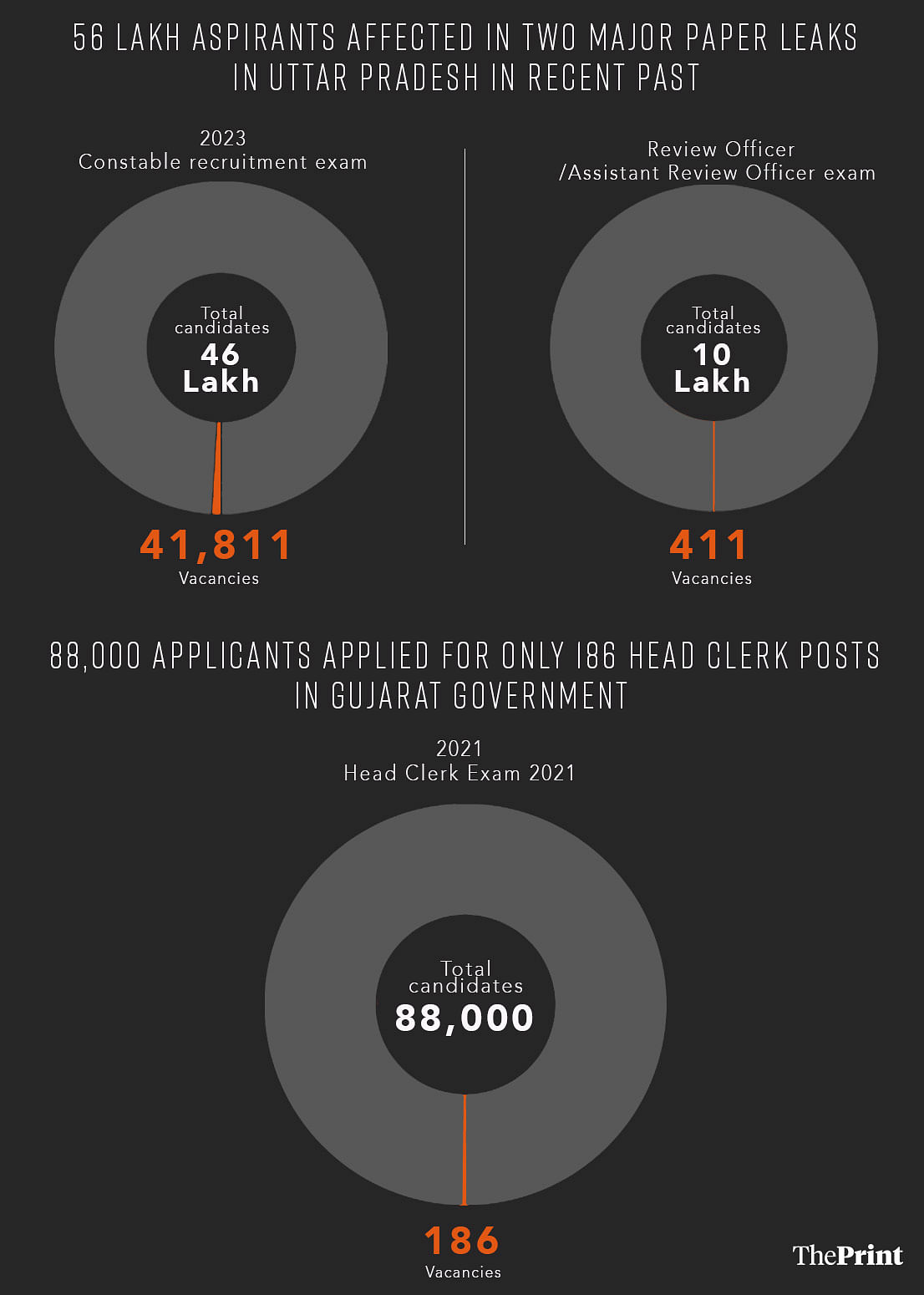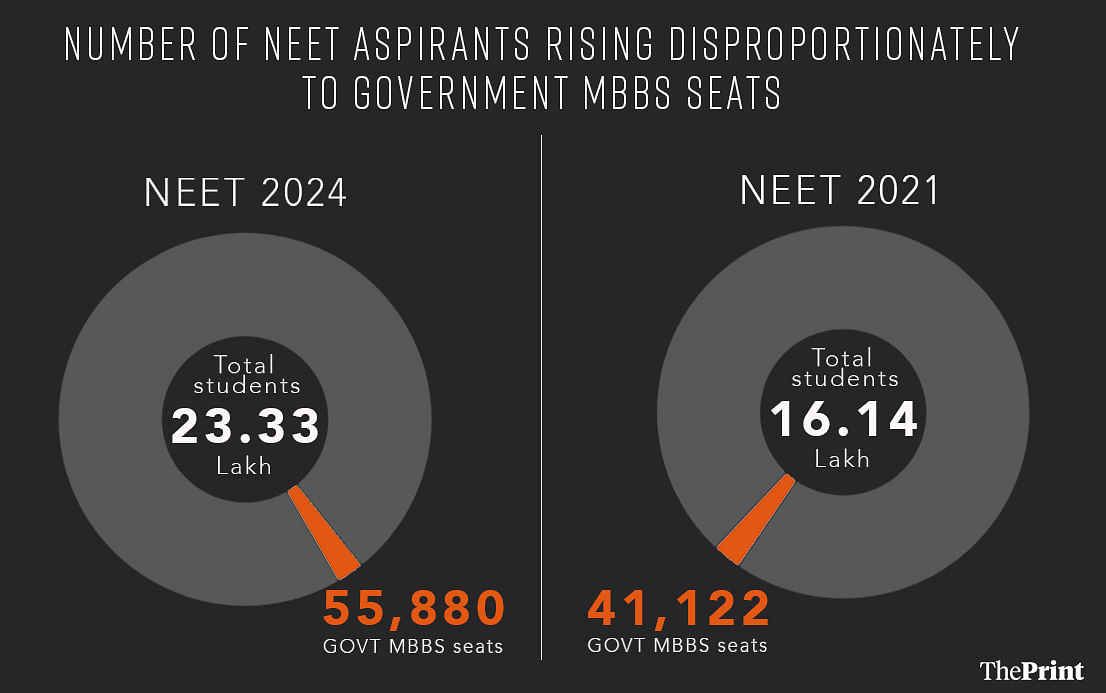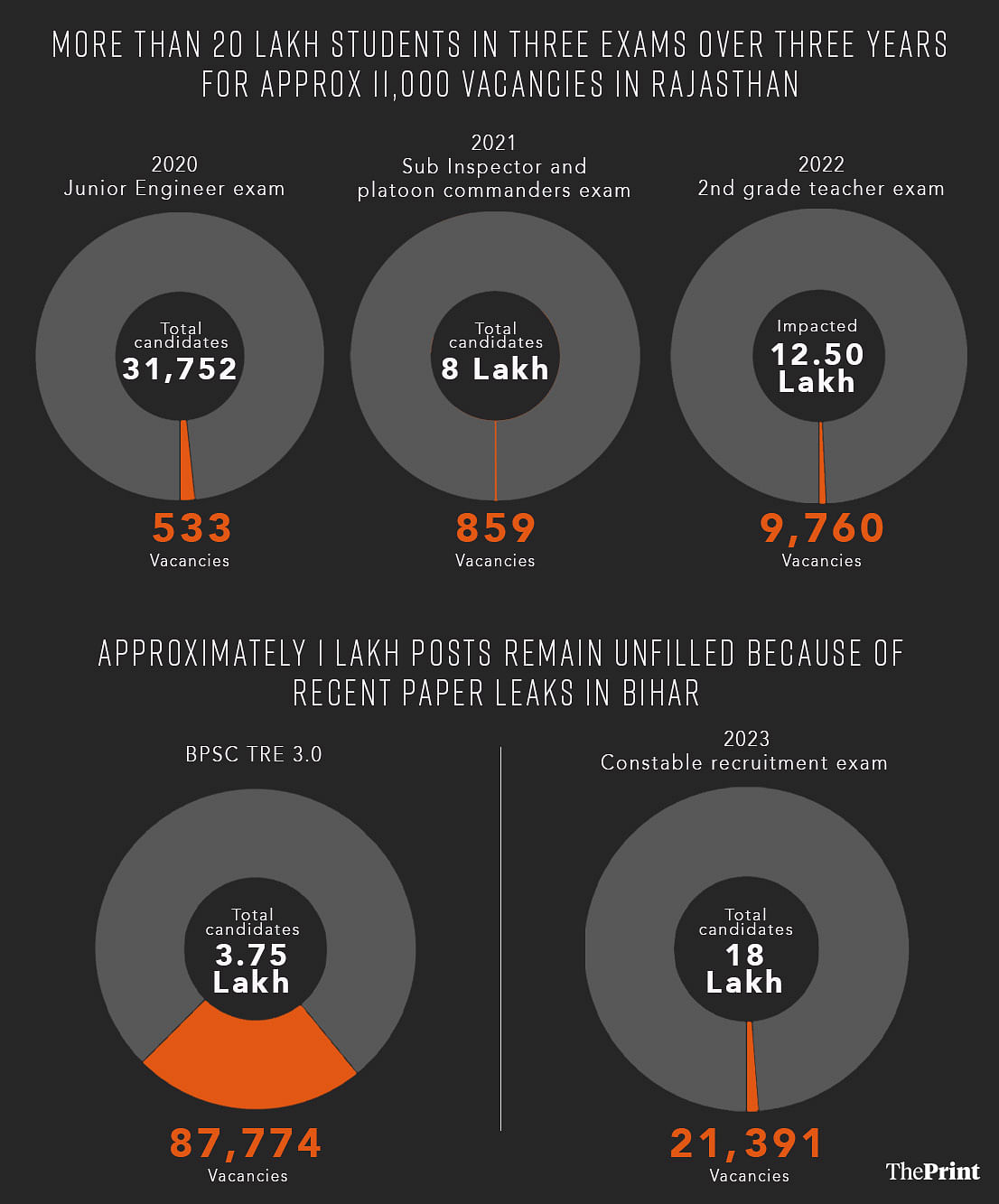New Delhi: Demand and supply dynamics, growing unemployment, rising desperation among the youth, with organised gangs capitalising on these vulnerabilities, plus a weak and leak-prone system — these are some of the reasons why states with a high youth population, low per capita income and poor growth indices are more prone to paper leaks, experts told ThePrint.
Added to this mix is the National Testing Agency (NTA), currently in the spotlight for alleged irregularities in its conduct of National Eligibility cum Entrance Test-Undergraduate (NEET-UG).
According to the International Labour Organisation’s India Employment Report 2024, the country’s youth (aged 15-29) account for 83 percent of the unemployed population and that those from populous states like Uttar Pradesh, Bihar, Rajasthan, and Madhya Pradesh “fare poorly”.
Incidentally, these states are also among the most vulnerable to paper leaks.
Former Bihar director general of police Abhayanand said that the rampant issue of paper leaks in Hindi-speaking states such as Bihar, UP, MP and Rajasthan are largely a reflection of a stagnant economic environment where employment opportunities are limited.
Economists and Opposition parties have also raised concerns over unemployment and the lack of major national recruitment drives despite numerous vacancies.
“There is no flourishing industrial sector in these states compared to states in the southern and western part of the country where the private sector can step up in providing employment. At the heart of these paper leaks in these states lies the stagnant economy which is failing to create enough quality employment opportunities leading to increasing demands for government jobs,” Abhayanand told ThePrint.
In the past five years, there have been media reports of eight paper leaks from Uttar Pradesh, around seven each from Rajasthan and Maharashtra, and six from Bihar, including in the 2023 constable and teacher recruitment exams. Gujarat and Madhya Pradesh each reported around four cases. These states together account for 52 percent of the country’s youth population.
Speaking to ThePrint, a UP Police officer said, “The media and public come to know of the cases that get reported and there is outrage. But action is also taken in cases where there are tip offs. It is a flourishing industry…. These states come up at the top because of reported cases and arrests”.
Lakhs of aspirants have been affected by such paper leaks over the years, shows data collated from government websites and news reports.
Over the past few years, there have been alleged paper leaks in NEET 2024, affecting nearly 23.33 lakh aspirants competing for 1,08,915 MBBS seats; and NEET 2021, affecting 16.14 lakh aspirants. In Rajasthan, the 2020 Junior Engineer exam leak affected 31,752 aspirants, and the 2021 sub-inspector and platoon commanders’ exam leak affected 8 lakh aspirants. The 2022 Rajasthan 2nd grade teacher exam leak impacted 12.50 lakh candidates.
In Bihar, this year’s Public Service Commission (PSC) teachers’ recruitment test leak affected 3.75 lakh candidates, and last year’s constable recruitment exam leak impacted 18 lakh students. In Uttar Pradesh, the 2023 constable paper leak affected 46 lakh aspirants, and the Review Officer/Assistant Review Officer exam leak affected 10 lakh candidates. The 2021 Gujarat Head Clerk Exam leak impacted 88,000 aspirants.

According to Kiran Bhatty, a senior visiting Fellow at the Centre for Policy Research, paper leaks are a “symptom of a larger problem”. This problem originates from a two-pronged gap — between the demand for quality higher education and its limited availability, and between the labour market’s requirement for highly skilled individuals and the level of education currently provided by the education system.
“Dealing with question paper leaks alone will be just treating the symptoms. Governance solutions such as an independent governing body would be a good start, but that alone does not solve the essential problem,” Bhatty told ThePrint.
In Part 3 of ThePrint’s series on paper leaks, we explore why the Indian examination system is marred by paper leaks and what are the possible solutions to make the system leak proof.
Also read: Repeat offenders, loopholes in law — inside India’s multi-crore paper leak industry
Limited seats for NEET aspirants
According to Bhatty, streams such as engineering, medical, or social science are overburdened because other academic options that can provide new-age skills and make youth employable in new industries, such as digital marketing and hospitality, have not yet opened up.
There has been an unprecedented demand especially for MBBS seats at government colleges. Hence, when the issue of the alleged paper leak surfaced, it brought attention to the challenges facing medical education in India and issues within the NTA.
Government data shows a significant growth in both the number of medical colleges and MBBS seats over the past decade. Medical colleges have increased from 387 before 2014 to 706 currently, with MBBS seats rising from 51,348 to 1,08,940. Despite this expansion, the number of NEET applicants has consistently exceeded the number of available seats, with applicants rising from 16.14 lakh in 2021 to 23.33 lakh this year, indicating a persistent gap between demand and supply.

Maheshwer Peri, an educationist and founder-CEO of Careers360, pointed out that the increasing number of NEET applicants reflects the limited options available to biology students compared to engineering students, who have sufficient affordable college choices.
The second problem, said Peri, is the lack of affordable private medical education in the country, which forces students to keep repeating NEET examinations, making the exams another version of the Union Public Service Commission (UPSC).
“There is a 30 percent repetition of candidates every season of NEET because 95 percent of parents cannot afford medical education in private colleges. You can complete MBBS in government colleges at 5 lakhs while fees at private colleges can extend up to Rs 1 crore,” Peri said to ThePrint.
According to a study conducted by the expert group of the National Medical Commission, which the government made public in December 2022, the median annual fee for MBBS in private colleges is Rs 11.5 lakh a year. In comparison, students were asked to pay a meagre Rs 30,000 in the first academic year at the University College of Medical Science, a public-funded medical college in Delhi.
Peri suggested that state governments looking to increase the number of medical colleges, government or private, in their states — like Tamil Nadu had tried last year — should be allowed to do so. He, however, added that in case of private medical institutes, there should be a cap on fees.
“There is a glass ceiling for biology students, which makes it so that they can’t do anything except MBBS, and exorbitant fees at private colleges further limit their options to only clearing the NEET exam to secure government medical colleges, which are scant compared to the demand. The current system is based on 2 percent merit and 2 percent rich, where 2 percent of students who qualify NEET get medical education while 2 percent rich who can afford higher college fees get admission in private colleges,” Peri added.
A ‘toothless’ NTA
The NTA itself faces the problem of outsourcing and lack of manpower.
The NTA was formed as an autonomous and self-sustained testing organisation in 2018 under The Societies Registration Act, 1860, after being approved in 2017 to bring “qualitative difference” in the examination process. It was aimed at standardising the entire examination process through a single test instead of conducting multiple examinations.
The 10-member governing body is headed by a chair occupied by former UPSC chairman Pradeep Kumar Joshi. It comprises NTA’s DG, three directors of the Indian Institute of Technology, and two directors from the National Institute of Technology, among others.
A former bureaucrat told ThePrint that under clause 4.42 of the National Education Policy, NTA was envisaged to conduct one examination for all competitive courses, which should have been a departure from a pre-existing system where examinations for engineering, medical and academic courses used to be organised separately.
The ex-bureaucrat added that while it copied the model of separate examinations to be changed from CBSE, it never had the experience or the manpower to succeed.
“It borrowed the model, which was deemed flawed and a burden to CBSE, but anyway, it did not have the wherewithal and manpower to match the execution of the CBSE. NTA was never going to succeed with the old model of CBSE,” the officer explained.
Another former ministry officer said that while the stakeholders of the examinations conducted by the CBSE — such as supervisors and superintendents at exam centres, the schools or institutions selected as centres, and officials entrusted with the responsibility of conducting examinations — are completely involved, stakeholders of tests conducted by the NTA do not have any such involvement because of large-scale outsourcing.
“CBSE had 16 regional centres, and it had enough manpower to man every examination centre with its own staff to maintain tight vigil and direct communication, which is no longer found anywhere because of outsourcing,” the official explained.
“NTA’s structure is based on vendors and outsourcing. Except for the DG and a few directors, no employees of NTA have a direct stake. Few people can be 100 percent sure of vendors. NTA does not have the wherewithal to go regionally, district-wise, or state-wise to verify whether centres are okay or if the invigilators and observers have been properly selected. It just has to rely on vendors, even for verification,” the official said.
“All aspects of the examination — selection of examination centres, conduct of examinations, packaging, transportation of OMR sheets, and evaluation of OMR sheets — have been outsourced. NTA does not have the power and wherewithal to deal with the responsibilities it has been entrusted with.”
Several former officials said that NTA should be regulated by an act of the parliament to shed its “toothless” status and make its orders binding on the state government and other authorities.
Some officials also suggested that the NTA should work with similar bodies, such as the CBSE and UPSC, so that their “established good practice” can be replicated. NTA should also be able to tap into their resources during big-scale examinations.
NTA should work in tandem with CBSE and UPSC to tap into their resources, and the ministry of education should pass executive orders to state governments to empower NTA in the conduct of examinations,” former CBSE chairman R.K. Chaturvedi told ThePrint.
One bureaucrat quoted above also suggested that the NTA should prefer government colleges and the government should chip in to improve technology at those institutions to enable the NTA to conduct examinations. The official said this would make the examination centre more accountable because the supervisors and superintendents would have their careers at stake in case of any malpractice.
“CBSE used to conduct examinations at schools affiliated with the board, which gave the board the power to enforce stringent protocols. Schools and institutions had to comply with all the norms to ensure their affiliation with the board remained intact. Schools or institutions with shady management practices were never allotted examinations as part of the principle,” the official said.
Need ‘quality & integrity’
Questioning the use of pen and paper methods in state public service commission examinations, former Rajasthan PSC chairperson L.K. Panwar said that the commission should go for the digital mode of examination, but only after employing the most robust possible cybersecurity measures and protocols.

“For every possible human and physical problem, there are digital and technological solutions,” he told ThePrint, but added that this alone won’t bring change.
He further said that most of these commissions have been used by state governments to accommodate officers and members from different groups for the purpose of social engineering to gain political dividends.
“Commissions should be run on quality and integrity, not based on caste representation. Commissions are not for social engineering,” retired IAS Panwar said to ThePrint.
Similarly, the former chairperson of Bihar PSC, Atul Pradhan, emphasised the deployment of people with clean and impeccable track records at the top and the identification of organised gangs to stop their impact on the education system and leakage at the commission level.
“There should be an audit of the functions of all components to find out each possible gap, and there should be an attempt to try steps such as printing question papers right at the centres for small-scale examination to at least make them tamper-proof,” retired IAS officer Pradhan told ThePrint.
Similar to medical and engineering institutes, government services also witness a substantial number of aspirants sitting for examinations.
Speaking to ThePrint, Professor M. Rajivlochan of Panjab University explained that several factors, such as lucrative salaries at middle and low levels paired with benefits as compared to private sectors make the youth of India desperate for government jobs.
“A government peon or multi-tasking employee takes anything up to Rs 30,000 per month at the start, as well as health insurance for them and their families that takes care of any health needs. In many states, employees are also entitled to housing at a meagre amount. The facilities available to government sector employees are extraordinarily better than employees at their level in the private sector,” Rajivlochan told ThePrint.
“The concept of job security for mid-level and low-level employees plays a huge role in their preference and desperation for government jobs,” he added.
(Edited by Zinnia Ray Chaudhuri)
Also read: Complicit officials, fragile supply chain, gangs on the lookout — anatomy of a paper leak






